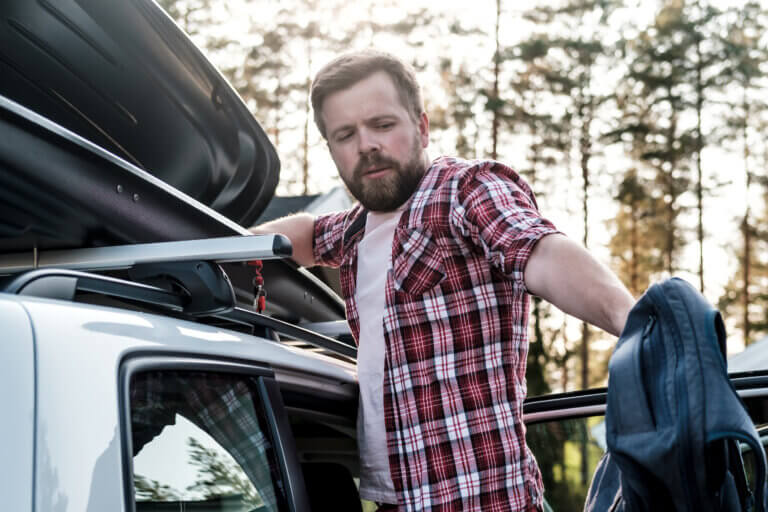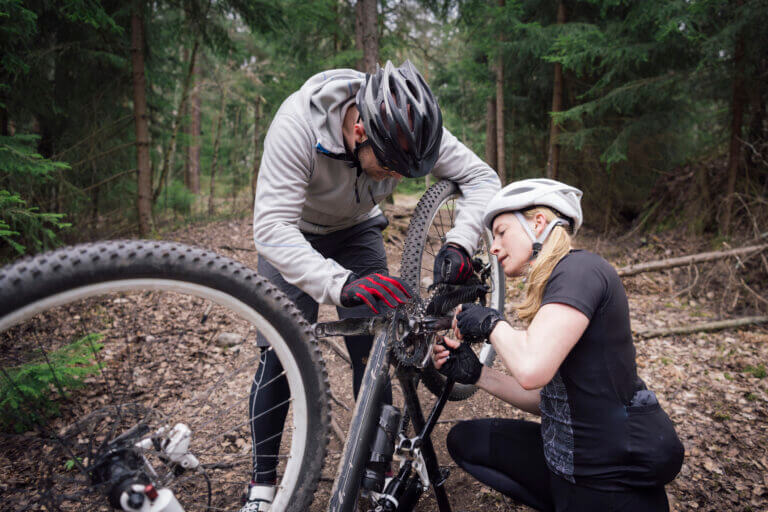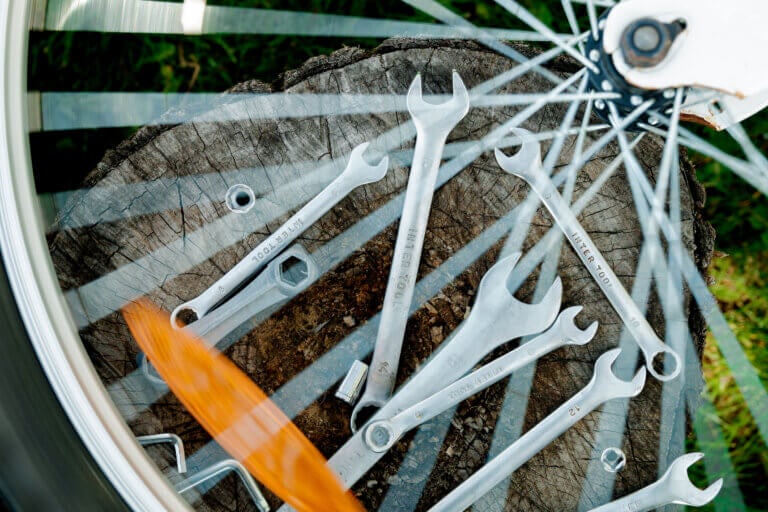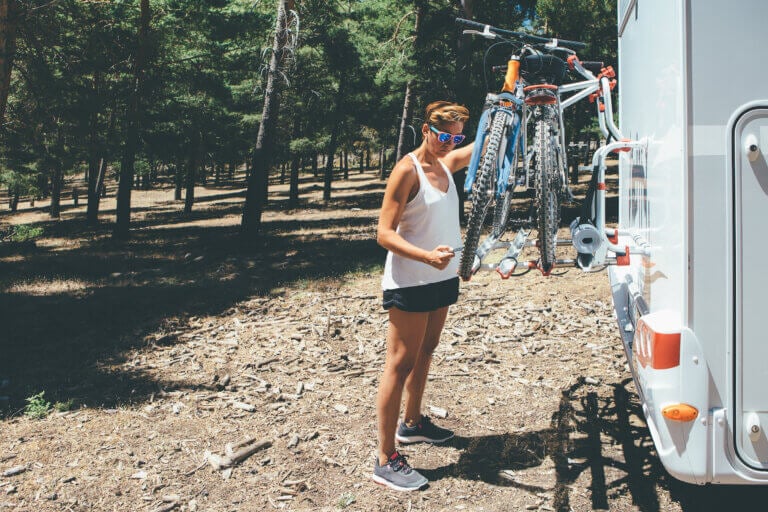How To Transport Your Bicycle
Discover the most popular ways cyclists transport their bikes.

Adventure — it’s one of the things cyclists love most. From oceanside paths to mountain trails, getting from one beautiful spot to another is half (if not all … ) the fun. If you need to transport your bicycle from point a to point b, and you can’t cycle there, here are some useful tips on how to do it.
What’s in this article?
- How to transport your bicycle on a car with racks
- Best ways to transport bicycles in a car
- Transport your bicycle in a car without taking it apart
- Transporting a bicycle without a rack
- How to transport a bicycle in an SUV or pickup truck
- The cheapest ways to ship a bicycle
- Additional resources for cyclists
How to transport your bicycle on a car
If you have a smaller car and can’t fit a bicycle inside, or if you simply need the space inside the cab, reach for some racks. There are a few different types of racks and they each have their own pros and cons. Take a look at the racks below to discover which ones will work best for you.
Try the simple trunk mount bike rack
Best for cyclists who don’t need to transport their bicycle back and forth a lot, the simple trunk mount bike rack fits around the rear end of your car.
Trunk mount bike rack pros:
- Easy to install and uninstall
- Affordable
- Better for people who don’t want to lift things overhead
Trunk mount bike rack cons:
- At risk for bicycle theft
- Higher risk of damage during transit (e.g. if you’re rear-ended)
- No access to your trunk
- May scratch your car during installation
Install a traditional roof bike rack
You’ve probably seen these on road trips — families traveling down the highway with bikes strapped to the roof of their car, minivan, or truck. They’re a popular choice because they keep the inside of your car and trunk clear, and you can transport multiple bicycles at once.
Roof rack bike pros:
- Extra space in your car and trunk
- Lower risk of damage during transit
- Affordable
Roof rack bike cons:
- Poor gas mileage
- Adds to the height of your car (e.g. you might have to find alternate routes or parking spots)
- Hassle learning how to get the bicycles on and off the racks
Use a hitch mount bike rack
For the best of many worlds, cyclists opt for hitch mount bicycle racks. Ideal for people who own vehicles with tow hitches, these bike racks are versatile and easy to use.
Hitch mount bike rack pros:
- Reduces drag, which increases fuel efficiency
- Easy to get bicycles on and off the racks
- Keep the inside of your vehicle and trunk clear
Hitch mount bike rack cons:
- Can be expensive
- Higher risk of theft
- Higher risk of damage during transit (e.g. if you’re rear-ended)

Best ways to transport bicycles in a car
Many cyclists transport their bicycles inside of a car because it’s safe, and it’s affordable. You can skip the racks and the risk of transporting on your car, or in a truck bed — but it can be tricky and you’ll probably have to take it apart depending on the size of your car.
Check out these tips on how to get your bicycle from point a to point b without having to strap anything to the roof.
Fit your bicycle in the back seat of your car
The bigger the backseat of your car is, the easier this will be. If you have a two-seater, a smaller electric vehicle, or another compact car, this might not be the option for you. But if you have a sedan or larger, this could be your best bet.
Tips on how to transport your bicycle in the backseat of your car:
- Clean off your bicycle first so the seats don’t stain
- Wrap or cover the pedals with cloth (or something soft) to avoid scratches
- Pivot the pedals to slowly maneuver the bicycle into the backseat
- You may have to pull the passenger seat up to give yourself more room
- If the bicycle won’t fit easily, try taking the front wheel off
- Don’t force it — if it doesn’t fit, it doesn’t fit
- Be aware that having a bicycle in the backseat may be a safety hazard
- Use bungee cords or seat belts to secure your bicycle in place
Try the trunk of your car
If your car has a trunk, you could be in luck. The trunk of your car not only keeps your bicycle dry, but it also keeps it out of sight — which means you’re at lower risk of theft. You’ll need some tools for this one, though.
Tips on how to transport your bicycle in the trunk of your car:
- Clean off your bicycle first so the trunk doesn’t stain
- Remove the front wheel of your bicycle
- You may need to remove the back wheel of your bicycle as well (depending on the size of the trunk)
- Pivot the pedals to maneuver the bicycle into the trunk
- Don’t force it — this risks tearing your trunk’s upholstery or bending your frame

Transport your bicycle without taking it apart
If you need to transport a bicycle somewhere and you don’t have the tools to take it apart (or just don’t want to disassemble it), you have a few options. Try these methods below for transporting your bicycle without taking it apart.
Install bicycle racks on the back or top of your vehicle
- Pros: Inexpensive
- Cons: Could scratch your vehicle
Use a roof-mounted bicycle case
- Pros: Easy to install
- Cons: Really expensive
Try fitting it in the back of your vehicle or in the trunk
- Pros: It’s free
- Cons: Might not fit
Use a truck bed
- Pros: Easy if you have a truck, or know someone who does
- Cons: Not so easy if you don’t have access to a truck …

Transporting a bicycle without a rack
For cyclists traveling with their gear, but without racks, there are few options to try out. You might need some tools to remove wheels for this one, or some additional merchandise, before your trip.
Use a vacuum mount
If you aren’t using a roof bicycle rack because you don’t want to scratch up your car, maybe a vacuum mount is right for you. Instead of attaching to crossbars, these use suction to secure your bicycle to the roof or trunk.
Take advantage of your backseat or trunk
Pop off the front (and possibly rear) wheel, adjust the pedals, and pivot the bicycle around carefully to get inside your vehicle. This might take a few tries and you may have to clear out everything in your car first. However, this isn’t great for cyclists traveling together in a single vehicle, or for people who have smaller cars.

How to transport a bicycle in an SUV or pickup truck
So you’ve got a bicycle, you’ve got a bigger vehicle, and you’ve got places to go — what a wonderful scene. If you have a truck or SUV, transporting your bicycle is going to be a little easier. You’ve got several options, check them out below.
Trunk mount bicycle racks
Easily attach a bicycle rack to the trunk of your SUV. These types of bike mounts are relatively inexpensive, but you give up some accessibility to your trunk. Great for saving space in the inside of your vehicle, and you get to skip the aerodynamic drag that will decrease your fuel efficiency.
You might need some extra security though if you plan on making a lot of stops. Because your bicycles are exposed, they’re prone to theft. Also, be on the lookout for people tailing you on the road. If someone rear ends you, your bicycles might get smashed in the process.
Hitch mount bicycle racks
These types of bicycle racks are better for trucks and SUVs with tow hitches. Not only are they easy and affordable to install, but they’re also farther away from your trunk. If you’re rear-ended in a car accident, your bicycles still might be damaged — but your vehicle might not be. Plus, you’ll have an easier time getting in and out of your trunk.
Roof bicycle mounts
To save space inside your pickup truck or SUV, opt for roof bicycle mounts. Because these keep your bicycles on the roof, they’re less likely to be stolen and less likely to be damaged in a car accident. Just keep an eye on your gas mileage — they’ll affect your vehicle’s ability to aerodynamically cut through highway winds.
Back seat or truck bed
If you secure your bicycles properly in the back seat or truck bed, they’re less likely to be damaged in a car accident and less likely to be stolen. However, you’ll probably need to get the bike tools out to pop the front and rear wheels off if you’re working with a small space. You’ll also give up precious interior cargo space for other passengers or items you need to transport.
Front bumper mount bicycle racks
If none of the other bike transport methods are working for you, give the front bumper mounts a try. They’ll save space inside the cab and keep your trunk clear. They might reduce your fuel efficiency a little bit, but not as much as roof racks will. Plus, if you get rear-ended, your bicycles are less likely to be damaged in an accident. You will need a vehicle that’s pretty high off the ground though in order to see over the racks, and make sure they don’t drag on the ground.
The cheapest ways to ship a bicycle
If you’ve explored every bicycle transport option and they just aren’t in the cards, you might need to ship it. Plus, shipping a bicycle can save you headaches in the long run — especially if you have a long drive or flight ahead of you.
Shipping a bicycle can be expensive, and there’s always the possibility of it being stolen or lost during transport. It’s recommended you invest in a solid bicycle insurance policy before shipping in case something bad happens along the way. Plus, Simple Bike Insurance offers policies starting at just $100 a year.
Proceed at your own risk and make sure you trust the carrier. Here are a few tips on how to ship your bicycle safely, and affordably.
Private shipping companies
Businesses like UPS and FedEx can and do ship bicycles and nearly everything else. Prices may vary based on the size and weight of your bicycle.
Depending on which company you choose to ship with, it can cost anywhere from $50 to several hundred — and that price might change because of location. For example, shipping a bicycle from one city to another that’s nearby may be less expensive than shipping across the country.
Remember to factor in the price of packing supplies as well. If you choose to ship your bicycle without taking it apart, you’ll need a much larger box. On the other hand, you might be able to save money with a smaller box, but you’ll have to take your bicycle apart. Don’t forget to buy packing tape, styrofoam, packing peanuts, or other things to protect it against transit damage.
Private companies that specialize in shipping bicycles
ShipBikes, Sport Express, and BikeFlights each offer services specifically for cyclists. The average cost of shipping is usually lower than companies like UPS or FedEx — and they might include special boxes meant for bicycles.
You’ll likely have the option to ship in your own box should you choose to use a hard case. Alternatively, you can invest in shipping containers meant for bicycles like XBike or Aircaddy.
How to securely pack up your bicycle before shipping
First, you’ll need to decide how your bicycle will be shipped. If you ship it as one piece you’ll need a different box than if you ship it disassembled. Use these tips below on how to make sure your bicycle is as safe as possible.
- If you can, take apart your bicycle and ship it in pieces
- Wrap things like pedals or other metal bicycle parts
- Use zip ties, bubble wrap, or other packing materials to secure it
- Invest in a sturdy box or caddy — avoid using basic cardboard boxes not meant for bicycles
- Ask your local bicycle shop for assistance
Know ahead of time if you’re dropping it off, or if the shipping company will pick it up
Invest in a bicycle insurance policy to financially protect yourself against loss or damage during transit
Check your bicycle if you’re flying
If you choose to fly to your destination instead of drive, you might be able to check your bicycle as luggage. Be sure to contact the airline beforehand for guidelines and rules so you aren’t stuck at the airport with a bicycle you can’t check.
You’ll probably need a hard case to check a bicycle and, depending on its weight, you may have to pay a little extra in luggage fees. There’s also a decent chance you’ll need to take apart your bicycle to get it in a hard case or shipping caddy.
Additional resources for cyclists
No matter how you choose to transport your bicycle, there’s always risk of theft, loss, or damage. Protect yourself and your bicycle from these risks with an affordable, comprehensive bicycle insurance policy. Coverage starts at just $100 a year — and policy benefits will reimburse you for all qualifying events.
Build your own bicycle insurance policy and start with an instant quote that’s totally free. It takes just a few minutes and you can easily add or remove premium coverage options based on your budget, and your cycling needs.
Check out these additional resources to learn about bicycle insurance, theft, and more. If you have any questions, reach out to us online or give us a call. We’re here to help get you on the right track.
Be sure to follow Simple Bike Insurance on social media for interesting reads, important updates, and more. You can find us on Facebook, Instagram, and Twitter.
